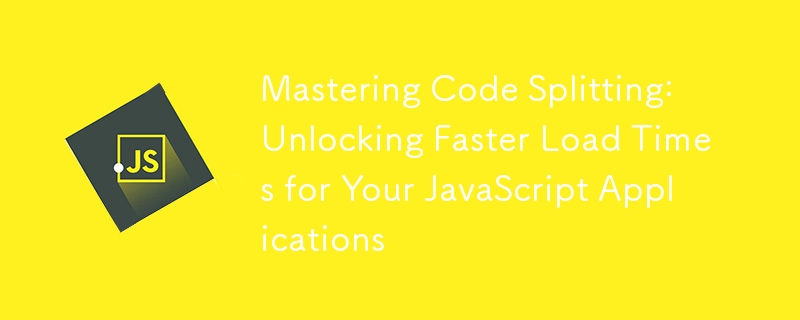

As web applications grow, the size of JavaScript bundles can become a significant factor in your applications performance. Large bundles can lead to slower load times, and as bundles get bigger, load times increase. Thankfully there’s a technique called code splitting that helps solve this problem. Let’s dive into what it is and how you can implement it in your project.
Code splitting allows you to split your JavaScript bundle into smaller pieces which can then be loaded on demand. Instead of loading an entire application at once, you only load the code needed for the current user interaction and defer loading the other code until it’s actually required. This can drastically improve load times.
Let’s face it, we’ve all been there when we are trying to load something, it’s taking too long and we exit out. A faster load time directly translates to a better user experience. Code splitting helps keep users engaged by delivering a snappy, responsive experience, and when your users are engaged, they are more likely to stay on your site, explore its content, and check out your services.
Now imagine you have a large application where all the code is bundled into a single file. Every time this application is used, the entire bundle is loaded in, even if only a fraction of the functionality is being used at that moment. This is very inefficient and will slow down your application. By implementing code splitting, you reduce the initial bundle size, resulting in a faster load. Only the code that is being used at that moment is pulled in while the rest is waiting to be called in.
Similar to how bundling tools like Webpack or Rollup implement tree-shaking, they also bundle your JavaScript files into one or more output files, often called “chunks”. These chunks can then be loaded in as needed, which is where code splitting comes into play. Below we’ll go over implementing code splitting with dynamic imports and route-based splitting.
One of the simplest ways to implement code splitting is through dynamic import() statements. Unlike static imports, dynamic imports allow you to load a module only when it’s needed. Here’s an example:
import('./module').then(module => { module.doSomething(); })
In this case, module.js is only loaded when the import statement is executed, not when the application initially loads. This allows you to defer loading code until it’s actually required.
For single-page applications (SPAs), route-based code splitting is a great approach. This allows you to load different chunks of code depending on which route the user navigates to. In a React application, this is very easy to do using React.lazy and React.Suspense. Here’s an example:
const Home = React.lazy(() => import(‘./Home’)); const About = React.lazy(() => import(‘./About’)); function App() { return ( Loading… In this example, the Home and About components are only loaded when the user navigates to their respective routes. This keeps the initial bundle smaller with additional code being loaded on demand.
It’s crucial to understand the impact of code splitting on your bundle sizes. Tools like Webpack Bundle Analyzer can help you visualize your bundle’s structure and identify areas for optimization.
To further optimize load times, consider using preloading and prefetching. These techniques allow you to hint to the browser to load certain resources ahead of time. Here’s an example of what that would look like:
Preloading ensures that critical resources are loaded as soon as possible while prefetching loads resources that might be needed in the near future.
Code splitting is a powerful optimization technique that can significantly improve the performance of your application which allows for a better user experience. By loading only the code that’s needed when it’s needed, you can reduce initial load times and keep users engaged. Implementing code splitting in your projects is an important step towards building faster, more efficient web applications.
If you found this helpful, consider subscribing to myweekly newsletterwhere I help hundreds of other developers like you level up and advance in this field. And let’s face it, better skills = more money!
The above is the detailed content of Mastering Code Splitting: Unlocking Faster Load Times for Your JavaScript Applications. For more information, please follow other related articles on the PHP Chinese website!




